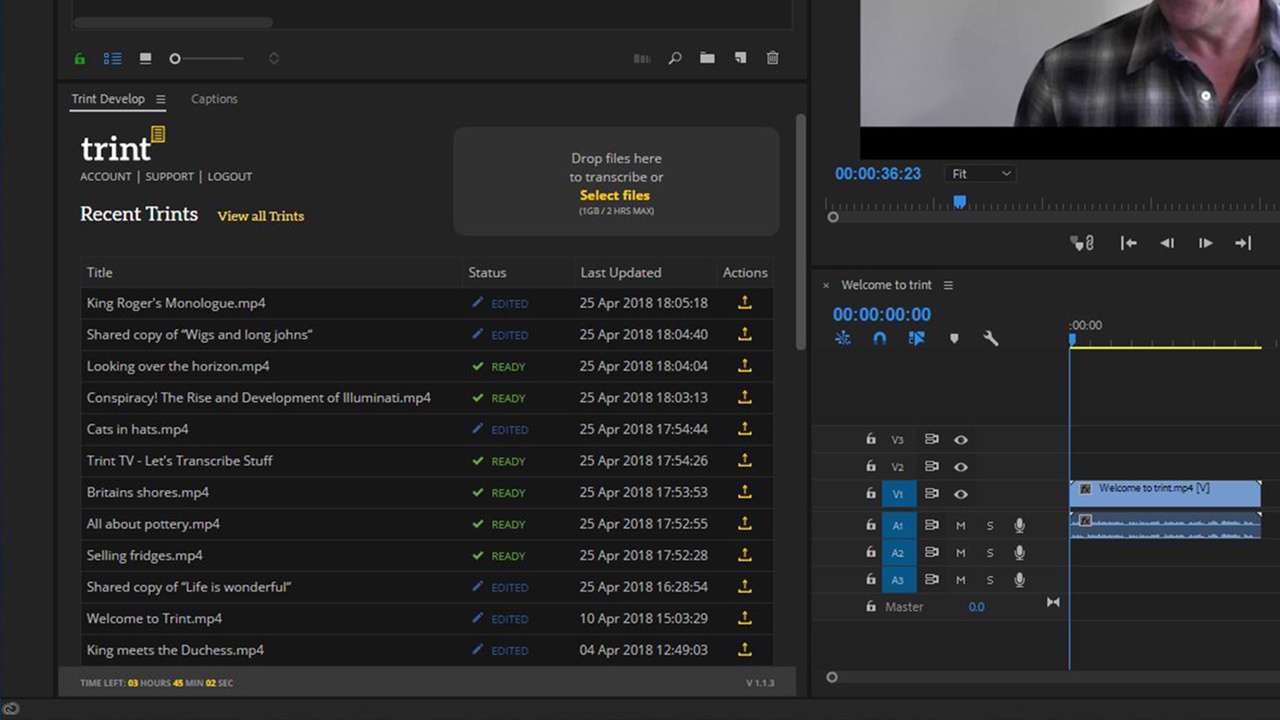Transkription oder Sprach-zu-Text ist gefragter denn je. Ob Journalisten, Videoredakteure, Anwälte oder Ärzte, die Notwendigkeit, Audio oder Video in Text zu konvertieren, wird zweifellos irgendwann in den Arbeitsablauf vieler verschiedener Fachleute einfließen. Und wenn Sie in einer dieser Karrieren oder Branchen tätig sind, hatten Sie vielleicht sogar die gefürchtete Aufgabe, Audio- oder Videodateien selbst in Text umzuwandeln.
Wir fühlen deinen Schmerz.
Der einfachste Weg, diesen Prozess zu definieren, besteht darin, aufgezeichnete Sprache in Text umzuwandeln. Wenn Sie jemals die Worte eines Schauspielers oder die Zeilen eines Politikers gelesen haben, dann haben Sie ein Protokoll gelesen. Es gibt viele verschiedene Arten, wie Transkripte verwendet werden; und glücklicherweise bietet die Technologie die schnellste und kostengünstigste Möglichkeit, Sprache in Text umzuwandeln als je zuvor.
Die traditionellste Art, Sprache in Text umzuwandeln, ist die manuelle Transkription, bei der Menschen Audio- oder Videodateien anhören und die Wörter in ein Textverarbeitungsdokument eingeben. Manuelles Tippen ist in der Regel zeitaufwändig, aber genauer als menschliche Tippdienste in Echtzeit, die extrem schwer zu beherrschen sind, es sei denn, Sie sind ein außergewöhnlich schneller Tipper.
Einige manuelle Schreibkräfte entscheiden sich dafür, die Wiedergabegeschwindigkeit der Audio- oder Videodateien zu verlangsamen, damit sie in ihrem eigenen Tempo tippen können. Dieser Ansatz führt in der Regel zu einer genaueren Abschrift, ist aber bei langen Audio- und Videodateien immer noch zeitaufwändig.
Mithilfe einer speziellen Ausrüstung und eines Kurzschriftsystems kann eine sehr kleine Anzahl von Personen in Echtzeit tippen, obwohl dies eine hochspezialisierte Fähigkeit ist, die eine umfangreiche Ausbildung und eine besonders schnelle Schreibkraft erfordert, z. B. ein Gerichtsreporter. Diese Fähigkeit kann entweder live oder beim Anhören einer Aufnahme eingesetzt werden, obwohl sie in den allermeisten Fällen live stattfindet. Die Genauigkeit ist in der Regel geringer, wenn dies in Echtzeit erfolgt, da keine Zeit für die Korrektur von Fehlern bleibt.
Obwohl es manuelles Tippen am längsten gibt, heißt das nicht, dass es die ideale Lösung ist. Wir glauben, dass es einen besseren Weg gibt.
Im Vergleich zur manuellen Eingabe ist die automatische Transkription unglaublich schnell. Für die manuelle Umwandlung von Sprache in Text muss die Quellaufnahme in der Regel in mehrere Dateien aufgeteilt werden. Diese Dateien werden dann an mehrere Personen gesendet, die für die Eingabe nach Stunden oder pro Seite bezahlt werden. Bei automatisierter Transkription hingegen wurde all dies mit einer einzigen Audio- oder Videodatei erreicht, und das in kürzerer Zeit, für weniger Geld und viel sicherer.
{{cta ('34c0ca44-29bb-4118-9ed7-165100108617', 'justifycenter')}}
Die Verwendung der automatisierten Speech-to-Text-Plattform von Trint ist so, als würden Sie einen Computer mieten, um Ihre Audio- oder Videodateien anzuhören und einzugeben. Die Software hört sich Dateien an und interpretiert dann mithilfe der Spracherkennungstechnologie, was gesagt wird. Sobald eine Datei in Text konvertiert wurde, wird das Dokument in einem Browser angezeigt, sodass Sie es leicht suchen, bearbeiten (falls erforderlich) und exportieren können.

Wir sind die ersten, die zugeben, dass künstliche Intelligenz (KI) nicht perfekt ist. Am Ende erhalten Sie einen ersten Entwurf, ein zeitcodiertes Transkript, das die Bearbeitung reibungslos und schnell macht. Bei einigermaßen klarem Audio liegt die Genauigkeit in der Regel bei mindestens 95%. Um den Bearbeitungsprozess zu vereinfachen, werden die Wörter im Trint Editor an den entsprechenden Moment im Audio oder Video geheftet, sodass wichtige Momente oder Stichwörter leicht zu finden sind.
Die digitale Speech-to-Text-Plattform von Trint beginnt mit KI, automatisierter Spracherkennung und natürlicher Sprachverarbeitung. Wenn Ihnen diese Worte wie einschüchternde, hochtechnische Wörter vorkommen, machen Sie sich keine Sorgen — das Konzept ist eigentlich sehr einfach. Die Software ist sehr, sehr gut darin, all die verschiedenen Laute zu interpretieren, die menschliche Sprache ausmachen; sie ist genauso gut darin, diese Laute dem entsprechenden Wort in ihrem umfangreichen Wörterbuch in vielen verschiedenen Sprachen zuzuordnen. Nicht nur das, die Software lernt auch von selbst, also lernt sie ständig dazu und verbessert ihre Genauigkeit.
Glücklicherweise haben Fortschritte in der Spracherkennungssoftware zur Entstehung von KI-gestützten Diensten wie Trint geführt, die Stunden an Zeit sparen und erheblich weniger kosten als manuelle Sprache-zu-Text-Dienste.

Trint ist automatisiert Transkriptionssoftware kann mit mehreren Medientypen verwendet werden, einschließlich Audio- und Videodateien. Benutzer können Trint sogar verwenden, um Untertitel für Videos zu erstellen, dank unserer jüngste Partnerschaft mit Adobe und unser spezielles Plugin für die Adobe Premiere Pro-Videobearbeitungssuite. Die Software wandelt das gesprochene Wort in Text um und platziert die Untertitel automatisch zur richtigen Zeit im Video, sodass Redakteure nicht selbst Zitate heraussuchen und Untertitel hinzufügen müssen. EDL-Dateien (Edit Decision List) können mit dem Adobe-Plugin auch aus Trints importiert werden, sodass das Zusammenfügen mehrerer Clips der wichtigsten Momente in einem Video in wenigen Augenblicken erfolgt.
Aufnahme Clear Audio ist ein integraler Bestandteil vieler Branchen. Für Medien ist es wichtig, Interviews genau und klar aufzuzeichnen, um sie als Referenz und Zitat zu verwenden. Das Gleiche gilt für das Recht. Und Filmemacher verlassen sich aus Gründen der Barrierefreiheit auf Transkripte wie Bildunterschriften, Untertitel und Übersetzungen für fremdsprachige Veröffentlichungen.
Angesichts der Tatsache, wie wichtig es ist, Daten aus einer Vielzahl von Branchen korrekt zu erfassen (selbst ein unvorsichtiger Tippfehler kann zu einer Vielzahl von rechtlichen Problemen führen), ist es wichtig, die richtigen Tools zu verwenden, um die Genauigkeit zu gewährleisten. Und die Entwicklung der besten Tools zur Bewältigung dieser häufig auftretenden Probleme ist das A und O von Trint.
Wie bereits erwähnt, gibt es eine Handvoll Möglichkeiten um Audio und Video in Text umzuwandeln. Dieser Prozess ist jedoch fragmentiert, beeinträchtigt die Datensicherheit und ist gelinde gesagt ein langsamer und mühsamer Prozess.
Beim maschinellen Lernen wird noch einige Zeit vergehen, bis wir völlig fehlerfreie Trints sehen, aber es gibt Möglichkeiten, wie Benutzer die Genauigkeit aktueller automatisierter Lösungen verbessern können. Zahlreiche Faktoren können die Genauigkeit der maschinell generierten Sprache-zu-Text-Technologie beeinträchtigen, wie z. B. Hintergrundgeräusche und das Übereinander mehrerer Sprecher. Indem sie diese bei einer Audio- oder Videoaufnahme minimieren, können Benutzer die Genauigkeit digitaler Plattformen wie Trint erheblich erhöhen. Aus diesem Grund zeigt Trint, bevor ein Benutzer eine Audiodatei in Text konvertiert, eine kurze Checkliste mit Dingen an, auf die er achten sollte. Es ist unsere Art, mit Ihnen zusammenzuarbeiten, um die bestmöglichen Ergebnisse zu erzielen.
Da die Zahl der Personen, die Trint verwenden, weiter steigt, werden Sprache-zu-Text-Algorithmen immer genauer. Maschinelles Lernen ermöglicht es Computern, zu lernen, ihre „Ohren“ zu verfeinern und intelligenter zu arbeiten, während sie aus ihren Fehlern lernen. Die KI-gestützte Sprache-zu-Text-Technologie ist zwar nicht hundertprozentig, aber sie wird von Tag zu Tag besser — und das gilt auch für Trint.
Wir sind zuversichtlich, dass Trint sowohl die weltweit beste automatisierte Sprache-zu-Text-Plattform als auch die klare Wahl gegenüber menschlichen Tippdiensten ist. Warum nehmen Sie uns nicht mit auf eine Probefahrt? Melde dich hier an.